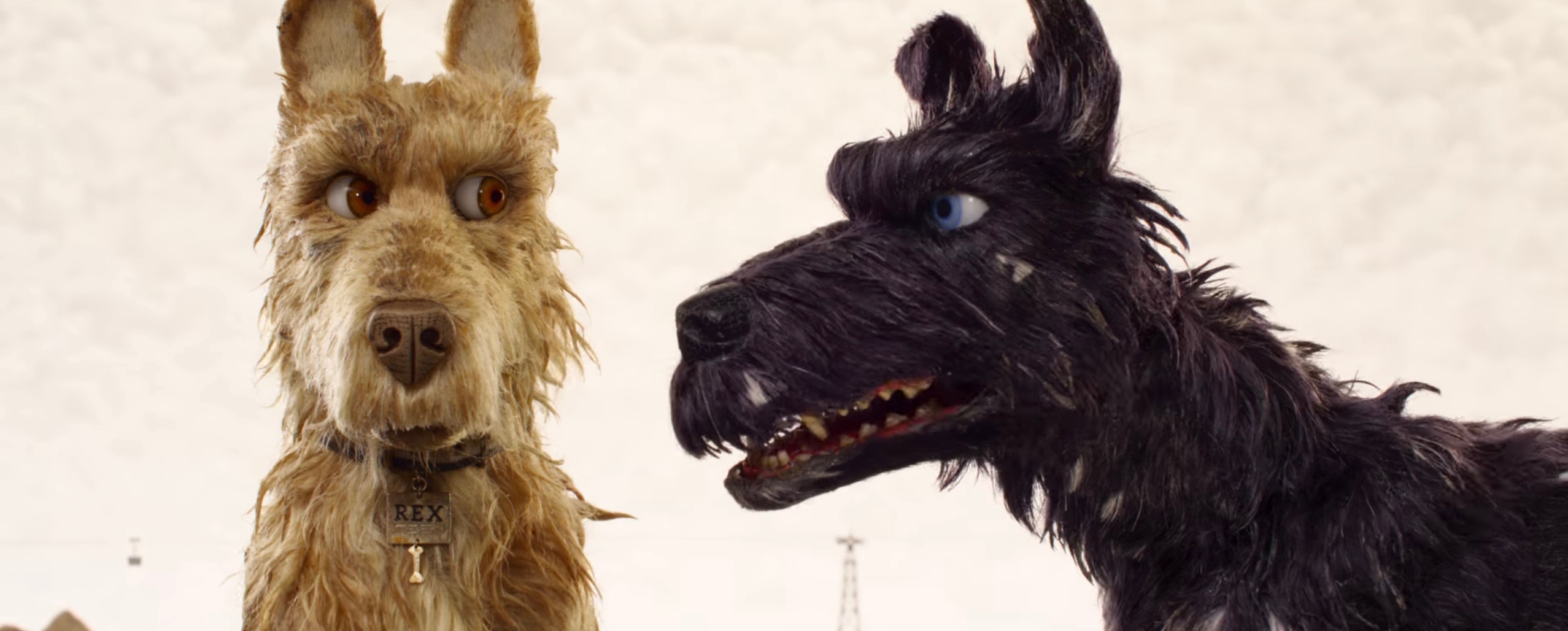Wes Anderson’s new dystopian stop-motion animation has the heart and soul of its dog heroes. Rose Brown reviews.
The release of Wes Anderson’s Isle of Dogs couldn’t have lined up any more perfectly – in the US it came alongside National Puppy Day and what would have been famed Japanese director Akira Kurosawa’s 108th birthday, in the Chinese Year of the Dog. It’s almost as if he planned it.
Given the enormous amount of dog lovers the world over, though, Anderson probably could have released the movie anytime and people would have gone crazy for it – there are dog-friendly screenings across the country as the film opens in the UK, plus, Twitter has been mind-blown by the title’s resemblance to ‘I love dogs’ when said aloud. All of these elements make the film seem absolutely adorable, but Isle of Dogs has a wacky and dark edge.
This is evident from the film’s plot. As is explained in a typical Anderson prologue, the cat-loving Kobayashi dynasty has been ruling over the fictional Megasaki City in Japan, and as an outbreak of dog flu and snout fever seizes the canine population, Mayor Kobayashi (Kunichi Nomura) orders a quarantine of all dogs on the nearby Trash Island.
Throughout the twists and turns of the plot, the film is fully immersed in Japanese culture, which has prompted accusations of cultural appropriation.
The first to go is Spots (Liev Schreiber), the bodyguard dog of Kobayashi’s orphaned nephew and ward, Atari (Koyu Rankin). Six months later, with Trash Island entirely populated by the former pets and strays of Megasaki, Atari crash lands there on his search for Spots and runs into the film’s main pack of protagonists – Chief (Bryan Cranston), Rex (Edward Norton), Duke (Jeff Goldblum), Boss (Bill Murray) and King (Bob Balaban). Thus begins their adventure.
Anderson peppers the main rescue plot of Atari and his canine friends with political dealings back in Megasaki, such as leader of the opposition Scientist Party Professor Watanabe (Akira Ito) and his search for a cure for dog flu, and American exchange student Tracy (Greta Gerwig) getting involved with a Pro-Dog activist group at her host school.
OH MY GOD
— Patti Murin (@PattiMurin) April 2, 2018
ISLE OF DOGS = I LOVE DOGS
THE TITLE IS LITERALLY I LOVE DOGS
Throughout the twists and turns of the plot, the film is fully immersed in Japanese culture, which has prompted accusations of cultural appropriation. Anderson’s choices are signposted from the beginning – Japanese characters speak in their native tongue, and are not translated unless someone is on hand to do so (usually Frances McDormand’s Interpreter Nelson).
The detail of the sets and homages to classic Japanese art such as Hokusai’s ‘Great Wave’ and Kurosawa’s epic cinema create the impression of a more careful and loving approach to the film’s setting than the clumsiness of cultural appropriation. The human characters in the story are no more good or bad simply due to their nationality, but just because they’re humans, and unlike dogs, not all humans are good.

Photo by Youtube/FoxSearchlight
Not all of the dogs think they’re good either – Chief is the only one of the main pack who was a stray in his former life in Megasaki, and the film’s strongest storyline follows his change of heart whilst trekking across the island with the 12-year-old Atari prompted by the nudging of show dog Nutmeg (Scarlett Johansson), who urges Chief to help Atari, because ‘dogs love 12 year-old boys, don’t they?’
The nature of friendliness, love and happiness – all the great canine traits – is a huge theme in the film as a whole. Anderson has insisted that audiences do not read too much into his films, but the subtext of Isle of Dogs clearly also resonates with the timing of its release. Kobayashi’s deportation-happy decrees and refusal to accept the fact that there may be a cure for dog flu echoes Trump and fake news, with additional allusions to Russia’s governance and the fear of those who are different. The dogs marooned on Trash Island never forget the love that their masters had for them, even when they sent them away.
The voice work from the main group of dogs is amazing – especially Cranston, who uses his typical deadpan delivery and his ability to ratchet things up for a really expressive and emotive Chief. Norton’s Rex is the main philosopher and ethical thinker of the pack, and his tones often got a good laugh, as does the gossip-loving, rumour consuming Duke, voiced by Goldblum.
The beauty of animation means that Anderson is able to cram in even more visual detail than usual for his work – the multicoloured variety of the shots and sets, as well as the fast-moving plot, mean that every frame is worth lingering over.
The score is more toned down to make up for the visual feast, often confined to dramatic drumming. Overall, the imaginative mind of Anderson and his collaborators really shines through in Isle of Dogs, with meaningful messages about openness and caring for others and for the environment shining through the sometimes dark and emotional storylines.
Isle of Dogs is now one of my favourite Anderson films, and it is amazing to see and enjoy one of the most creative and fun directors produce a real treat for both dogs and humans alike.
Photo credit:Youtube/FoxSearchlight








